garphield
Hazard to Self
 
Posts: 58
Registered: 9-12-2019
Member Is Offline
|
|
Nitrates in decent yield from the oxidation of melamine by calcium hypochlorite
A few months ago I read a post on here about how calcium hypochlorite will oxidize melamine to NO2, CO2, and water that seems to have been mostly forgotten. I decided to
try and see if it would be possible to use this to make nitric acid in sizeable quantaties, and it is. The reaction seems to take place through a
red-colored intermediate which persists for a few minutes before disappearing with bubbling, shown in this image.
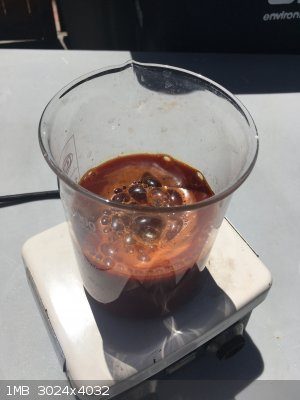
For this run, I used 5 grams of melamine powder and 95 grams of 73% calcium hypochlorite meant for pools. The theoretical yield of HNO3 is 15 grams by
the idealized reaction C3N6H6 + 12 Ca(ClO)2 -> 3 CO2 + 6 HNO3 + 12 CaCl2. In reality, it is probably less efficient, with some nitrogen only being
oxidized to N2 gas which then escapes. The melamine was added to about 500 ml of water in a one-liter beaker with very long stirring. Then, the
calcium hypochlorite was poured in as quickly as possible without having the stirring stop. This is necessary because before this, I tried the same
thing but with only 250 ml of water and just dumping all the calcium hypochlorite in at once. The foaming was much worse and it overflowed and went
everywhere.
Once the hypochlorite is added, the mixture rapidly turns red, as you can see above, before the red color disappears over a few minutes with some
bubbling. Once the suspended solids are filtered off, the filtrate has a lavender color which I think is from Mn impurities in the calcium
hypochlorite being oxidized to permanganate, which you can see in this image.
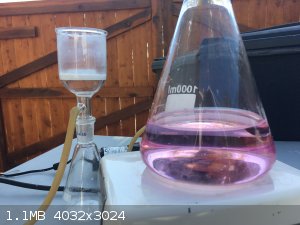
At this point, the filtrate appears to have a pH of 11-12, but the test strips are very rapidly bleached so I dont know for sure. I boiled down the
liquid, and near the end the lavender color rapidly disappeared. Once it cooled down, which you can see in the image below, there were a few crystals
that fell out of solution. The pH was now 6-7, and it no longer rapidly bleached the strip of pH paper.
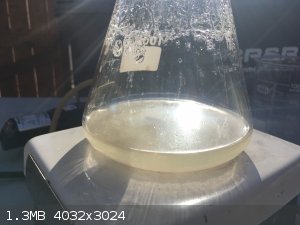
The solubility of calcium nitrate (~1.2 g/ml @20 C) is high enough compared to calcium chloride (~0.7 g/ml @20C) that by boiling down the solution
until stuff starts to crystallize out, most of the calcium chloride impurities can be removed with little loss of nitrate. If you don't do this, when
you treat it with sulfuric acid and try to distill off the nitric acid the HCl from the calcium chloride present will react with the nitric acid to
produce nitrosyl chloride and chlorine, destroying the nitric acid. Because not all of the chloride can be crystalized out, this will still happen to
some extent, but because three moles of HCl are needed per mole of HNO3 this should not completely destroy the yield. Because the liquid was not
boiled down enough in that picture, I concentrated down the salts until much more of them had percipitated out, although I did this by eyeball because
an error earlier on destroyed both some chloride and nitrate so there would be no way to calculate how much it had to be boiled down by because I
didn't know how much was dissolved. I then filtered out the CaCl2 and added an excess H2SO4 with some water to the remaining filtrate and set it up
for distillation, which you can see in the image below.
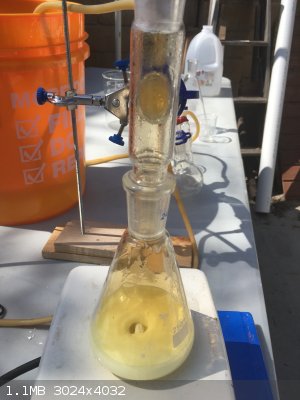
As you can see, there was a substantial amount of NO2 gas generated, confirming that a decent amount of nitrate is in the filtrate. I had a rubber
tube which all the gases had to go through which was several meters long and went to right behind a strong fan, which was okay for this scale, but
especially for larger scales it might be good to use a proper scrubber. The HNO3 collected in the receiving flask was slightly yellowish, and pretty
dilute because the sulfuric acid was diluted in about 3x its own volume in water before it was added to the flask. I continued distilling until the
excess H2SO4 became concentrated enough that it started bumping badly.
To figure out the yield, I put the collected acid in a beaker, covered it, and added two US 5 cent coins, which dissolved with the generation of a
large amount of NO2 as you can see in the image below. Each coin weighs 5 grams, and is 25% nickel and 75% copper by weight. This dissolves in nitric
acid via the reaction Ni + 3 Cu + 16 HNO3 -> Ni(NO3)2 + 3 Cu(NO3)2 + 8 NO2 + 8 H2O. 6.16 grams of metal dissolved, which would imply that there was
24.9 grams of nitric acid in the product, a 166% yield. Obviously this isn't the case, so either a substantial amount of the NO2 is oxidized back to
nitric acid by air in the beaker, the nitric acid is contaminated by HCl and/or H2SO4, or both. I added another coin after the first one completely
dissolved, and will weight it tomorrow to try and figure out how much was dissolved in total. Still, the large amount of NO2 in the beaker shows that
a decent yield of nitric acid is made by this method.
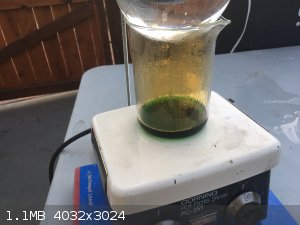
While melamine the chemical is not very OTC, melamine-formaldehyde resins are used to make some brands of kitchenware, sponges, and some types of
flooring, so if these can be used this may be a viable route to nitrate production. A few days ago, I put some pieces of a melamine-formaldehyde
sponge in a beaker with water and calcium hypochlorite. It did become discolored with some bubbling, but now the color is gone, although there is
still some bubbling, but the sponge is still visibly intact. This may mean that it takes a long time for the polymer to be oxidized, or it may mean
that it is basically not attacked at all, the initial discoloration was due to unreacted melamine, and the bubbling that is still going on is due to
the breakdown of remaining calcium hypochlorite. If this is the case, it may be possible to get melamine from melamine-formaldehyde resin by removing
the methylene bridges that link together the amine groups of the melamine in the polymer. Alternatively, although urea doesn't work, salts of cyanuric
acid might because they are based on a triazine ring, like melamine. It might be good to further investigate the mechanism of this reaction too. The
thread from several years ago linked at the beginning of this post says that sodium hypochlorite does not work, and a paper i read said that when
melamine is chlorinated normally, no nitrates are made, and instead some of the hydrogens on the amine groups are replaced with chlorine. Last night,
I posted this in the science in general subforum, but in the morning I realized that it was the wrong subforum and that this post was written in a
really rambling way, so I fixed it up, deleted the old one, and reposted it here. I don't think that breaks the rules, but I'm pretty new to the
forum.
[Edited on 20-6-2020 by garphield]
[Edited on 20-6-2020 by garphield]
|
|
|
JJay
International Hazard
    
Posts: 3440
Registered: 15-10-2015
Member Is Offline
|
|
This is excellent work.
|
|
|
Bromolone
Harmless

Posts: 20
Registered: 16-9-2019
Member Is Offline
Mood: Aldehydic
|
|
Great work!
Alternative sources to nitrates are the need of the hour, especially when they're getting rapidly phased out OTC.
For melamine, chemoleo suggests in a CCl4 thread using calcium cyanamide, a common plant fertilizer component:
| Quote: |
calcium cyanamide seems an interesting compound for other purposes- hydrolyiss with H2O (dont know what temp) yields free cyanamide (crystalline, mp
45 deg C) according to CaNCN+H2O +CO2--> CaCO3 + H2NCN. This dimerises at 80dg C to (H2N)2C=NCN, which can be converted to melamine (triamino
cyanuric acid) by heating in NH3.
|
You might prefer reading this too (CaNCN method):
https://patents.google.com/patent/US4069383A/en
(Also, when I dissolved some bleaching powder in water, filtered off the residue, and stored the hypochlorite for the haloform reaction, I had left
off the suspension of insoluble impurities in bleaching powder in water for days and soon noticed a pink coloration that darkened to purple over
weeks. Mn impurities are quite common in bleaching powder, as you suggested.)
Good documentation is key to good chemistry and software alike.
|
|
|
garphield
Hazard to Self
 
Posts: 58
Registered: 9-12-2019
Member Is Offline
|
|
sorry i was away for a few weeks but i havent abandoned this. that piece of sponge i put in a ca(clo)2 solution is still intact so i think that might
have failed, but i will try seeing if you can hydrolyze the polymer by refluxing in hcl without hydrolysing too much of the melamine. i would have
tried already but its extremely hot outside right now so im gonna wait a few days until the weather cools down. i read a paper that described a
perchlorate salt of melamine n-oxide and apparently the explosive properties are similar to those of hmx so thats another use of melamine that some
people here might be interested in.
|
|
|
RadicallyStabilized
Harmless

Posts: 35
Registered: 3-10-2018
Member Is Offline
|
|
Quote: Originally posted by Bromolone  | Alternative sources to nitrates are the need of the hour, especially when they're getting rapidly phased out OTC.
|
Potassium nitrate can be easily extracted from cheap chinese firecrackers with a bit of work.
Everyday consciousness classifies and subordinates, coerces under patterns of easy manipulation and disregards the essential.
|
|
|
symboom
International Hazard
    
Posts: 1143
Registered: 11-11-2010
Location: Wrongplanet
Member Is Offline
Mood: Doing science while it is still legal since 2010
|
|
Nope even that's getting rare you just have to stock up while in season after that it is illegal for vendors to sell outside specified days.
[Edited on 20-7-2020 by symboom]
|
|
|
garphield
Hazard to Self
 
Posts: 58
Registered: 9-12-2019
Member Is Offline
|
|
Brown ring test for nitrate on the water that had melamine-formaldehyde sponge and Ca(ClO)2 in it was negative. Tried looking for cyanamide-containing
fertilizers online and didnt find any place that sold them. Distilling some HCl so the dye or whatever was in the stuff when I bought it cant
interfere, will try refluxing bits of sponge in it for a while to see if I can get anything useful.
|
|
|
RadicallyStabilized
Harmless

Posts: 35
Registered: 3-10-2018
Member Is Offline
|
|
Quote: Originally posted by symboom  | Nope even that's getting rare you just have to stock up while in season after that it is illegal for vendors to sell outside specified days.
[Edited on 20-7-2020 by symboom] |
Well, any activity requires some amount of planning if you can't acquire the goods just in time when you need them.
Everyday consciousness classifies and subordinates, coerces under patterns of easy manipulation and disregards the essential.
|
|
|
phlogiston
International Hazard
    
Posts: 1375
Registered: 26-4-2008
Location: Neon Thorium Erbium Lanthanum Neodymium Sulphur
Member Is Offline
Mood: pyrophoric
|
|
There are many countries in which firecrackers or other potential sources of nitrates are simply unavailable. Its not a matter of planing, its simply
not possible to buy significant amounts of nitrates by legal means.
So, this is definitely a useful reaction.
Regardless, I found it very interesting. I didn't know about this reaction, and never seen this approach before. Its surprisingly efficient too.
-----
"If a rocket goes up, who cares where it comes down, that's not my concern said Wernher von Braun" - Tom Lehrer |
|
|
garphield
Hazard to Self
 
Posts: 58
Registered: 9-12-2019
Member Is Offline
|
|
Refluxed some pieces of melamine sponge in ~18% HCl, they dissolved in about half an hour. Don't think it got totally broken down tho because it's
much more soluble in water than melamine hcl is. When this is added to a NaOH solution, a lot of stuff precipitates out and floats to the surface,
which pure melamine does not do. It also gets a weird smell when a base is added, very fishy and not sharp like ammonia. Took some of the solution and
dried it out by heating it, sadly left it on the hot plate too long so all the water left and a lot of stuff sublimed off or was thrown out by
splattering but there was still a little bit of stuff left, maybe 0.2 grams. It was a bit tan but not charred too much, fortunately. I decided to put
in some water and calcium hypochlorite to see if it could be oxidized to nitrates, and I got the reddish color from the intermediate in the first
reaction so I think it works! Will try refluxing the rest of the solution to see if it can get hydrolyzed some more without too much melamine getting
hydrolysed, and then see if I can get enough stuff to actually isolate some nitric acid from it. Although the color change wasnt a confirmation, it's
still strong evidence that the oxidation to nitrate is taking place. Despite using a large excess of nitrate, the color change takes longer to start
and longer to go away, again fitting with the idea that the polymer hasnt been totally broken down.
|
|
|
Syn the Sizer
National Hazard
   
Posts: 591
Registered: 12-11-2019
Location: Canada
Member Is Offline
|
|
I don't know about the availability of calcium nitrate in other places, but I just buy a 3lb bag of calcium ammonium nitrate for 5$ from my local
garden shop, It's labled as calcium nitrate but I have no doubts that it also contains ammonium nitrate. I think the best method is to add an excess
of ammonium hydroxide and crash all the calcium out as it's hydroxide. Boil it down to remove as much calcium hydroxide as possible, calcium hydroxide
is one of the odd compounds the goes down in solubility with increase in temperature, similar to gasses. Also bubbling the ammonia produced through
your cold ammonia bottle.
Crystallize it into a salt for later use. If you want potassium nitrate, mix a small excess of ammonium nitrate solution to a solution of potassium
hydroxide, boil to remove the ammonium hydroxide again bubbling through the cold ammonia solution to recover it. For most uses a small impurity of
ammonium nitrate isn't an issue.
|
|
|
symboom
International Hazard
    
Posts: 1143
Registered: 11-11-2010
Location: Wrongplanet
Member Is Offline
Mood: Doing science while it is still legal since 2010
|
|
I was going to suggest adding urea to precipitate the nitrate out as urea nitrate then you could convert that to a nitrate salt then I reread and saw
that hypochlorite is used that just won't do unless there is no hypochlorite left so side reaction do not occur. Substituting with another oxidizer
but that is non halogen based such as chromate, permanganate or lead dioxide
Like how electrolysis such as lead dioxide anodes were applied for the production of glyoxylic acid from oxalic acid in a sulfuric acid electrolyte.
Melamine is produced by
In the first step, urea decomposes into cyanic acid and ammonia
Cyanic acid polymerizes to cyanuric acid, which condenses with the liberated ammonia forming melamine.
~~Changed my signature so it's organized and compact with my projects. When posting
[Edited on 5-8-2020 by symboom]
|
|
|
|